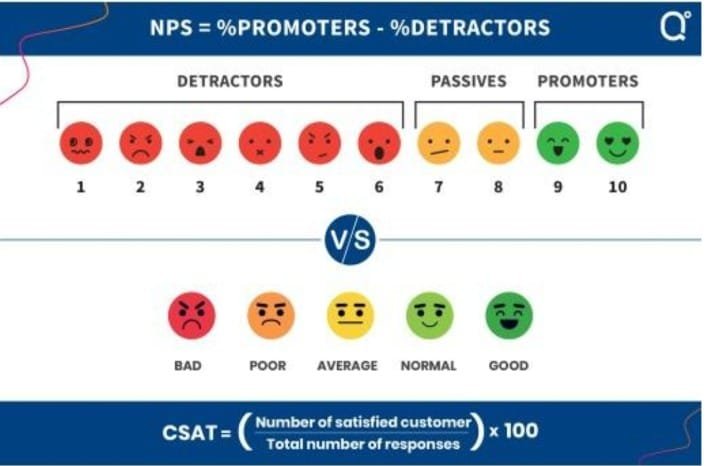Net Promoter Score(NPS) vs CSAT: What’s the Key Difference?
Customer satisfaction is top-notch for any business as it makes them keep coming back and bring others with them.

Customer satisfaction is top-notch for any business as it makes them keep coming back and bring others with them. So it’s not only that you retain more customers but also lower the new customer acquisition costs. However, when measuring customer satisfaction, businesses often stumble on choosing one out of Net Promoter Score or CSAT.
However, the reality is that both of these customer experience metrics work differently and give you a different picture, even when both measure customer satisfaction. So, that’s exactly what you’ll learn in this blog. So, without wasting time, let’s compare NPS vs CSAT.
What Is NPS?
NPS, or, Net Promoter Score is a metric used to measure customer satisfaction and loyalty to a brand. It’s a popular metric because it is used globally, and the reason for its popularity is its easy application. It helps businesses understand how satisfied their customers are with them and how likely they are to recommend them to others. A good NPS score for a company represents its success as a business.
What Does NPS look like?
An NPS survey contains a question like “On a scale of 0-10, how likely are you to recommend our product to your friends?” The respondent submits a rating from 0 to 10, where 9 to 10 means the customer is a promoter, 7 to 8 is passive, and the rest reflects that the customer is a detractor.
How to Measure NPS?
To measure this, you should first categorize the promoters and detractors. Now, find their percentages and put them into this formula.
Formula
NPS Formula = % of promoters – % of detractors
So, if there are 100 total customers, out of which 30 are promoters, and 10 are detractors, then the percentage of Promoters and detractors will be 30% and 10%, respectively. Moreover, the NPS will be:
NPS = 30% – 10% = 20%
What Is CSAT?
Customer Satisfaction Score or CSAT Score is another popular metric that helps you gauge the satisfaction of the customers. However, unlike the Net Promoter Score, it gauges the satisfaction transaction-wise. If you want to know the CSAT of your customer service, you can learn it by sending it right after the customer service interactions. You may confuse it for tNPS or transactional NPS, but there’s a clear difference that it simply gauges satisfaction with a direct question about it. At the same time, tNPS also gauges the loyalty factor by asking about the likelihood of a recommendation.
What Does a CSAT Survey Look Like?
A CSAT survey’s format looks similar to that of a Net Promoter Score as it also has a question and a rating scale. However, the difference can be seen in both. Firstly, the question directly asks about satisfaction without considering the likelihood of recommending the brand or its service/product. So, the question may look like this, “How would you rate your satisfaction with our service?”. To respond, the customer gets a rating scale, a simple 0-5 rating scale, a star rating scale, or a Likert Scale such as “Very satisfied, Satisfied, Neutral, Unsatisfied, Very Unsatisfied”.
How to Measure CSAT Score?
To find the CSAT score, count all the 4 or 5-rated responses and put them in this forum.
Formula
CSAT Formula= (Number of 4 or 5 rated responses/Total Number of Responses) × 100
It is because 4 or 5 represents satisfied or very satisfied customers. Since CSAT is about finding satisfaction, only satisfied customers are considered. Here’s an example to help you better understand CSAT calculation. Let’s say 120 responses have a rating of either 5 or 4. Moreover, the total responses are 200. So, the CSAT will be:
CSAT = (120/200) × 100 = 60%
NPS vs CSAT: What’s the Difference?
Let’s now analyze the key differences between NPS and CSAT. While you can figure out the basic differences on your own, like the format, formula, and type of scoring, in this section, we will examine the finer differences.
Key Focus
NPS focuses on customer satisfaction and loyalty and also considers a customer’s advocacy. However, its reach remains broader as it doesn’t occur very frequently.
On the other hand, CSAT only finds customer satisfaction, which is also true for specific interactions, like when the buyer is done ordering. So it remains transaction-specific.
Scoring Range
The scoring of NPS ranges between -100 and 100, which is not a simple scoring scheme like that you see with many metrics.
However, CSAT has a simple perfect rating, which can never go negative and remains between 0 and 100%.
When to Send?
You can send NPS after significant transactions or when you make changes or improvements. Moreover, you should also send rNPS at fixed times, such as annually, biannually, or quarterly.
On the other hand, CSAT surveys should only be sent after a transaction, such as when a buyer is done buying something to learn about their shopping experience or when a customer is done with a customer support interaction. They will let you know the customer’s interaction with your particular service or product.
Conclusion
NPS and CSAT are undoubtedly two very good metrics for measuring customer satisfaction. However, both of these metrics have aligned with different goals and objectives. So, when choosing one among them, you should first look at your business goals. However, as a business, employing both metrics is a good decision if you can define clear boundaries between your NPS program’s and CSAT program’s goals. Lastly, to make your NPS and Customer Satisfaction Score tracking easier, you should invest in a tool like the Net Promoter Score Tool by QDegrees, a great all-in-one solution for businesses that can measure NPS and CSAT in one place.









